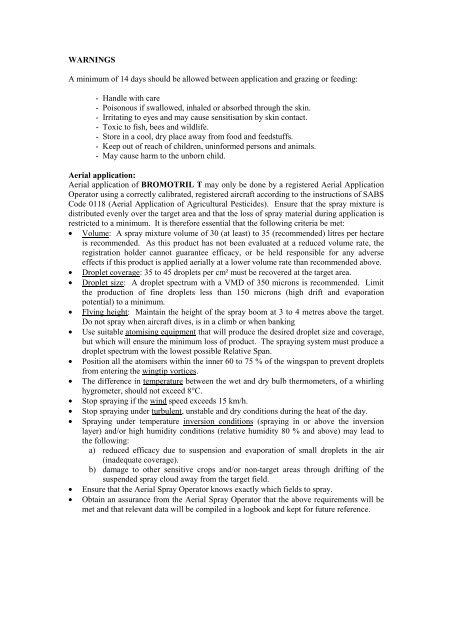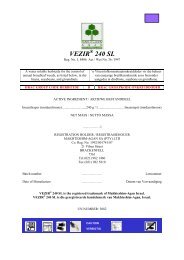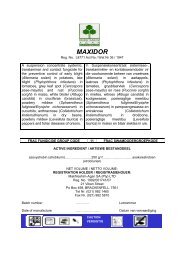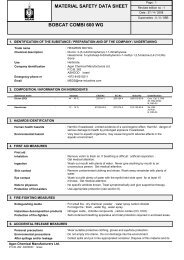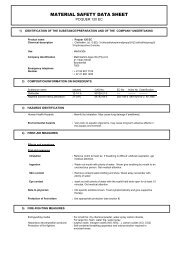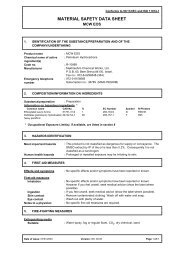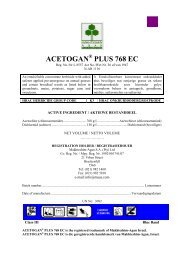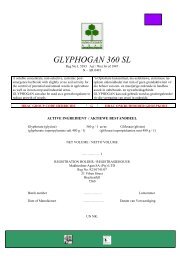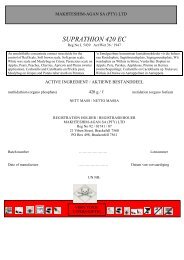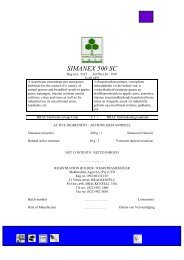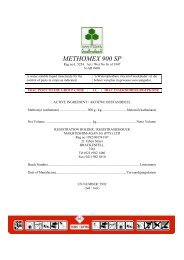BROMOTRIL T - Makhteshim-Agan
BROMOTRIL T - Makhteshim-Agan
BROMOTRIL T - Makhteshim-Agan
Create successful ePaper yourself
Turn your PDF publications into a flip-book with our unique Google optimized e-Paper software.
WARNINGS<br />
A minimum of 14 days should be allowed between application and grazing or feeding:<br />
- Handle with care<br />
- Poisonous if swallowed, inhaled or absorbed through the skin.<br />
- Irritating to eyes and may cause sensitisation by skin contact.<br />
- Toxic to fish, bees and wildlife.<br />
- Store in a cool, dry place away from food and feedstuffs.<br />
- Keep out of reach of children, uninformed persons and animals.<br />
- May cause harm to the unborn child.<br />
Aerial application:<br />
Aerial application of <strong>BROMOTRIL</strong> T may only be done by a registered Aerial Application<br />
Operator using a correctly calibrated, registered aircraft according to the instructions of SABS<br />
Code 0118 (Aerial Application of Agricultural Pesticides). Ensure that the spray mixture is<br />
distributed evenly over the target area and that the loss of spray material during application is<br />
restricted to a minimum. It is therefore essential that the following criteria be met:<br />
• Volume: A spray mixture volume of 30 (at least) to 35 (recommended) litres per hectare<br />
is recommended. As this product has not been evaluated at a reduced volume rate, the<br />
registration holder cannot guarantee efficacy, or be held responsible for any adverse<br />
effects if this product is applied aerially at a lower volume rate than recommended above.<br />
• Droplet coverage: 35 to 45 droplets per cm² must be recovered at the target area.<br />
• Droplet size: A droplet spectrum with a VMD of 350 microns is recommended. Limit<br />
the production of fine droplets less than 150 microns (high drift and evaporation<br />
potential) to a minimum.<br />
• Flying height: Maintain the height of the spray boom at 3 to 4 metres above the target.<br />
Do not spray when aircraft dives, is in a climb or when banking<br />
• Use suitable atomising equipment that will produce the desired droplet size and coverage,<br />
but which will ensure the minimum loss of product. The spraying system must produce a<br />
droplet spectrum with the lowest possible Relative Span.<br />
• Position all the atomisers within the inner 60 to 75 % of the wingspan to prevent droplets<br />
from entering the wingtip vortices.<br />
• The difference in temperature between the wet and dry bulb thermometers, of a whirling<br />
hygrometer, should not exceed 8°C.<br />
• Stop spraying if the wind speed exceeds 15 km/h.<br />
• Stop spraying under turbulent, unstable and dry conditions during the heat of the day.<br />
• Spraying under temperature inversion conditions (spraying in or above the inversion<br />
layer) and/or high humidity conditions (relative humidity 80 % and above) may lead to<br />
the following:<br />
a) reduced efficacy due to suspension and evaporation of small droplets in the air<br />
(inadequate coverage).<br />
b) damage to other sensitive crops and/or non-target areas through drifting of the<br />
suspended spray cloud away from the target field.<br />
• Ensure that the Aerial Spray Operator knows exactly which fields to spray.<br />
• Obtain an assurance from the Aerial Spray Operator that the above requirements will be<br />
met and that relevant data will be compiled in a logbook and kept for future reference.


